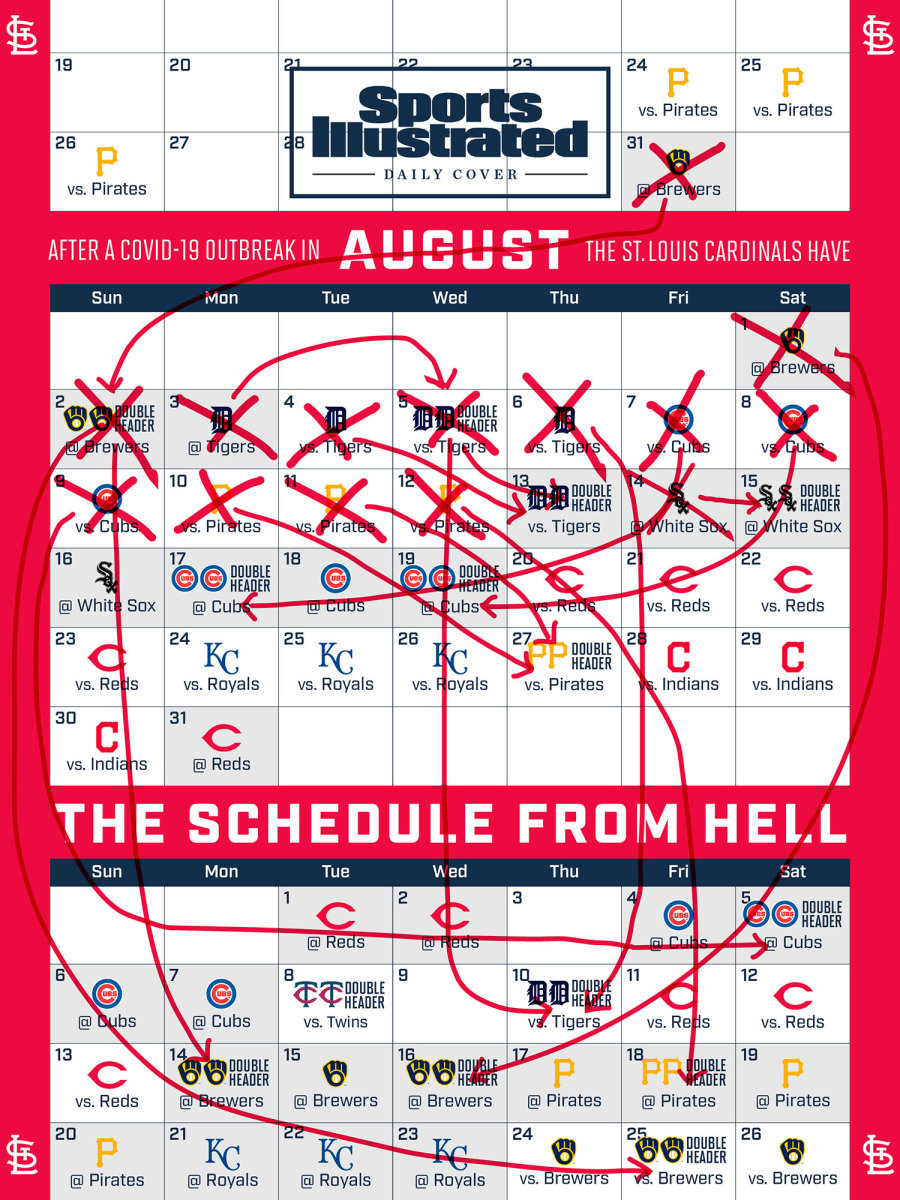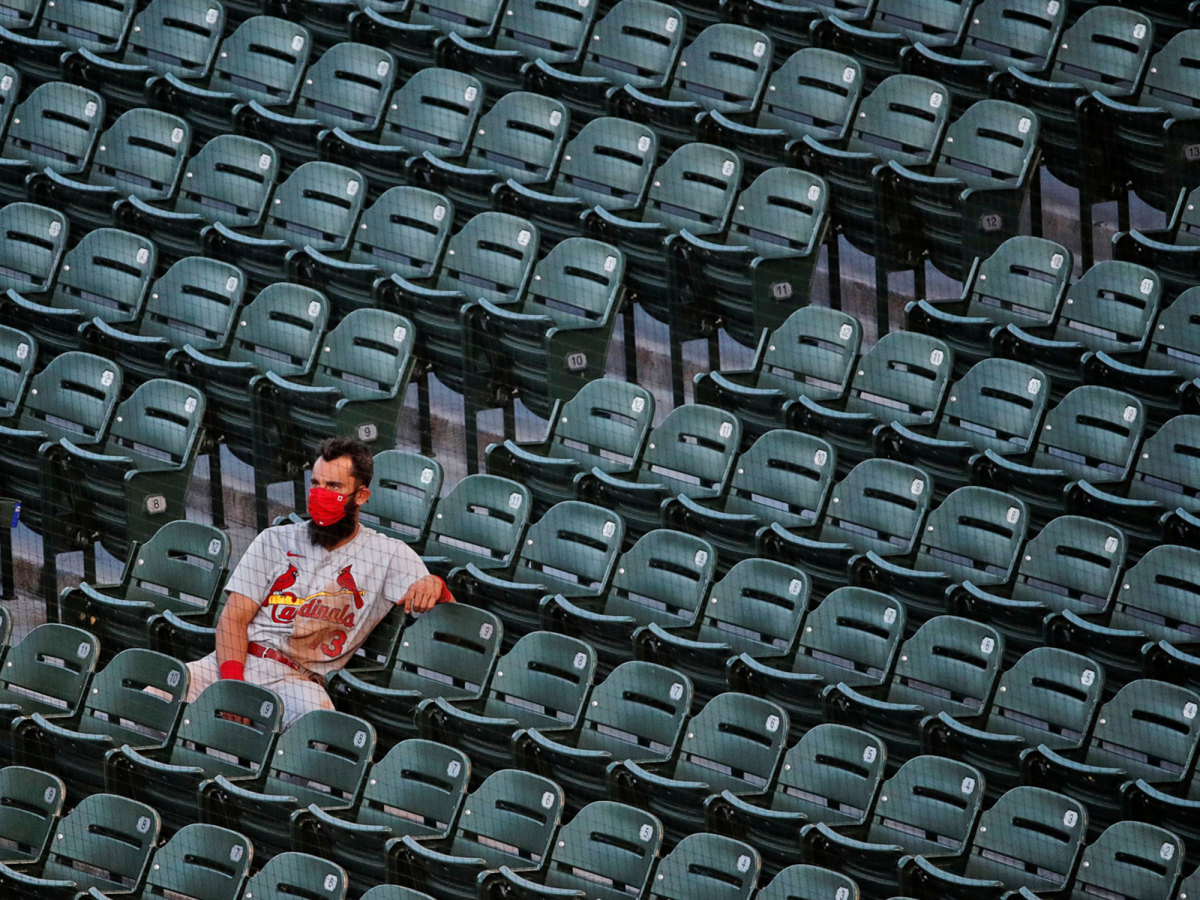Inside the Cardinals' Treacherous Game of Catch-up
Maybe someday the St. Louis Cardinals will laugh about the 2020 season the way fraternity brothers do their college days.
Remember the time pitchers quarantined in hotel rooms kept their arms loose by throwing into a mattress? Or how about the week eight players made their major league debuts, including the pitcher who gave up four straight home runs in his first inning? And then there was the time the Cardinals made like a youth travel ball team and drove 41 rental cars almost 300 miles to play eight games in six days against the Cubs and White Sox—BYO juice boxes and orange slices.

For the moment, however, just surviving one of the strangest seasons ever is a deadly serious day-to-day challenge, never more apparent than in an Instagram post this week from pitcher Carlos Martínez, one of 10 Cardinals players and eight staff members who tested positive for COVID-19. Masked, clad in a gown on his hospital bed and with an IV in his left arm, Martinez declared himself over the virus and wrote in Spanish, “Today I want to thank God for another chance at life.”
The Cardinals’ season was put on hold for 16 days because of a COVID-19 outbreak during a trip to Minneapolis and Milwaukee. It resumed last Saturday in Chicago. Other than in a strike year, it was the longest midseason shutdown for a team in baseball history, surpassing the 11-day shutdown of the 1903 Philadelphia Phillies after their stands collapsed.
St. Louis’s reconstituted schedule has it playing 53 games in 44 days—plus what would be an 11th doubleheader if the final two games held in abeyance impact playoff spots. The Cardinals get only two days off in those 44 days.
St. Louis faces obstacles like no other team, including the road construction that clogged I-55 north of Pontiac, Ill., and waylaid most of the 41-car caravan. On one hand the Cardinals face the urgency endemic to a 60-game season. On the other, they have pitchers who have not had time to properly train for it or who flat-out are not ready for the big leagues.
“Health is the most important thing,” says Cardinals president John Mozeliak. “Obviously, when you have 18 members in an organization test positive for COVID, that is very concerning. Almost as important is their baseball health. As we jump into these every-other-day doubleheaders you’re going to put a lot of stress on your bullpen. But we have to realize that for us this is like the second week of spring training.
“Starters can only go anywhere from one to three innings. With relievers, it’s not like it’s a normal midseason where you can use guys three days in a row. We’re trying to avoid back to back. We’ve told our players their health matters most. In the balance between their health and trying to win games, that’s what we’re going to err on. I’m sure there will be times when people will ask, ‘Why not pitch Pitcher X in that spot instead of Pitcher Y?’”
Says a rival general manager, “Their biggest challenge is not blowing out relievers. And their rotation was hair thin anyway with [Miles] Mikolas out. I could see them getting a quick boost because I’m sure those guys are eager to play after everything they’ve gone through. Long term? I don’t know.”
The Cardinals went 4-4 in their eight-game “Chicago Summer Tournament” against the White Sox and Cubs. Only twice did a starter last beyond the fourth inning. Among the newbies pressed into duty were Roel Ramirez, 25, who posted a 4.98 ERA last year in Double A. He faced eight White Sox batters and gave up six hits, including the four consecutive home runs. He departed with an ERA of 81.00.
Two days later, manager Mike Shildt removed starter Daniel Ponce de Leon after 79 pitches, which amounts to stretching his starter. Shildt then in succession called on relievers Seth Elledge (who made his major league debut two days earlier), Ryan Meisinger (who did not pitch in the majors last year after appearing in 18 games in 2018), Jesús Cruz (making his major league debut), and Nabil Crismatt (who made his major league debut the previous day). Meisinger and Cruz were added to the 60-man player pool only during the team’s 16-day shutdown. They threw a couple of bullpen sessions at the team’s alternate training site in Springfield, Mo., and found themselves at Wrigley Field a few days later. St. Louis lost, 6–3.
“We’re going to have eight major league debuts on this road trip,” Mozeliak says. “We had a third of our roster tested positive for COVID. As you can imagine, it’s going to create some difficulties. The biggest challenge for us is balancing the health of our players against the schedule.
“We’re trying to replicate as best we can to get guys ready. There’s no perfect map to follow. Obviously, we have to take advantage of our 40-man roster—even our 60-man roster. The rules we are working under were not designed for a team having an outbreak during a pandemic.”

Baseball teams have seen their schedules thrown into disarray before. In 1992 the Astros, having surrendered their home park, the Astrodome, to the Republican National Convention, endured an eight-city trip that covered 28 days, 26 games and 9,062 air miles. (They went 12–14.)
The 1991 Expos also played 26 games in 28 days on the road after a fallen beam closed their home park, Olympic Stadium. (Montreal went 13–13 on the 6,526-mile journey.)
The Phillies played nine doubleheaders in July 1944—and 44 for the season, when war-time doubleheaders were common to save gasoline.
The mother of all sojourns happened in 1899, when the Cleveland Spiders were such a poor draw at home that teams refused to travel there on account of such trips being money-losing propositions. The Spiders endured trips of 50 games and 36 games. They finished 20-134 with a cast of characters as colorful as the stickers on their suitcases. The Spiders featured Crazy Schmit, Harry (The Pitching Vegetable) Colliflower and Highball Wilson—and that was just their pitching staff.
But none among the 1992 Astros, 1991 Expos, 1944 Phillies and certainly the 1899 Spiders was a contender. None finished with a winning record. The Cardinals are defending NL Central champions, coming off a 91-win season largely intact—on paper, anyway.
On Wednesday, Jack Flaherty made his second start of the season—26 days after he pitched on Opening Day. Flaherty was one of the pitchers who repurposed his mattress in Milwaukee for a backstop while quarantined in his hotel room for six days. His start against the Cubs looked like a spring training outing: Shildt pulled him in the second inning after 41 pitches.
The Cardinals’ season went awry after only three games, apparently when players grew lax on protocols on the first trip, potentially including not wearing masks while sharing food indoors among groups of people. Mozeliak told reporters a breach “possibly” happened in “the dining halls.” The team has further tightened protocols since the outbreak.
Pregame batting practice has been reconfigured so “the number we put on the field is much smaller,” he says. The team provides grab-and-go meals at the hotel while discouraging players from eating at the ballpark. New rules were put in place for the airplane ride home from Chicago: no eating, no drinking and no socializing.
“The three pillars are, wear a mask, physical distancing and wash your hands,” Mozeliak says. “All of those we keep talking about. I definitely see a heightened awareness.
“We have an amazing group. There have been many days when people could have let down and yet they show up with a great attitude. Even during quarantine when they could only come out of room to test and then go back in, there were a few times when people were like, ‘Aren’t there other options?’ And we’d tell them, ‘No.’ And they accept it.”
In a season unlike none other, the Cardinals have a schedule like nothing else. How they’ll get through it is one for the history books.
“When I think about this club and how it will be defined,” Mozeliak says, “I think about it being one of the most patient, flexible groups there has ever been.”
